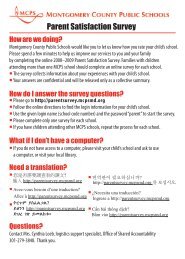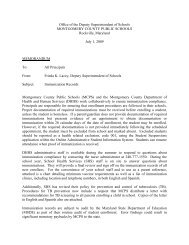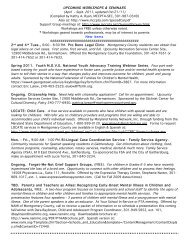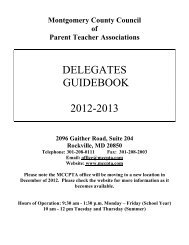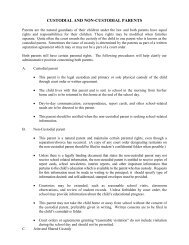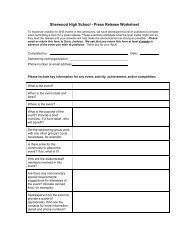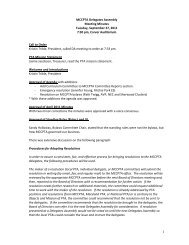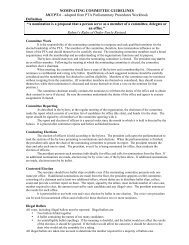Selected Writing Tasks and Rubrics - Mccpta.com
Selected Writing Tasks and Rubrics - Mccpta.com
Selected Writing Tasks and Rubrics - Mccpta.com
You also want an ePaper? Increase the reach of your titles
YUMPU automatically turns print PDFs into web optimized ePapers that Google loves.
<strong>Selected</strong> <strong>Writing</strong> <strong>Tasks</strong> <strong>and</strong> <strong>Rubrics</strong>Department of Curriculum <strong>and</strong> InstructionNovember 30, 2006
Question 3—CommentaryAdvanced Placement English Language <strong>and</strong> CompositionFree Response Commentary <strong>and</strong> Scoring RubricQuestion 3 asked students to formulate an argumentthat “defends, challenges or qualifies” critic LewisLapham’s assertion about the symbolic importance ofwealth in America. Lapham argues that for Americansmoney is the “currency of the soul” as opposed to themore intangible values of social class, honor, or intellectthat he finds promoted in European countries.The passage is long <strong>and</strong> <strong>com</strong>plex, much more thansimply a prompt for taking a position to argue from, butwriters wrote longer than usual essays in response,reflecting perhaps the interest the topic generated inthem. Even the least skillful papers demonstrated someunderst<strong>and</strong>ing of Lapham’s position, though they oftensimplified it or did little more than paraphrase the text.Somewhat better responses identified issues butexhibited uneven development in making theirarguments, or provided limited evidence to support theircontentions.Successful essays understood how to use evidencefrom experience or reading to create an argument of theirown. They made their case with skill <strong>and</strong> conviction.Their approaches varied from employing personalnarratives, to making analogies with a host of examplesfrom Jay Gatsby to Herbert Spencer, to critical analysisof Lapham’s own logic. These essays persuaded,through their own rhetorical choices, convincingly <strong>and</strong>eloquently.Scoring GuidePoints:9 Essays earning a score of 9 meet all thecriteria for papers that earned 8 points <strong>and</strong>,in addition, are particularly persuasive orcarefully reasoned or demonstrateimpressive stylistic control.8 Essays that earned a score of 8 persuasively defend,challenge, or qualify Lapham’s assertions about theAmerican “faith in money.” They present cohesive<strong>and</strong> carefully reasoned arguments using appropriateevidence from their knowledge <strong>and</strong>/or experience todevelop their positions. Their prose demonstratestheir ability to control a wide range of the elementsof effective writing, but they are not flawless.7 Essays earning a score of 7 fit thedescriptions of essays that received 6 pointsbut are distinguished by fuller or morepurposeful argument or stronger prose style.6 Essays earning a score of 6 adequately defend,challenge or qualify Lapham’s assertions aboutAmericans' peculiar beliefs about money bypresenting arguments that are generally sound<strong>and</strong> that use appropriate evidence. A few lapses indiction or syntax may be present, but for the mostpart the prose of these essays conveys the writers’ideas clearly.5 Essays earning a score of 5 underst<strong>and</strong> thetask <strong>and</strong> make assertions to defend, challengeor qualify Lapham’s notions about Americanbelief in money. Their arguments are generallyclear, but may use superficial or limitedevidence or exhibit uneven development. Afew lapses in diction or syntax may be evident,but for the most part the prose of these essaysconveys the writers’ ideas clearly.4 These essays inadequately respond to the question’stask. They may misunderst<strong>and</strong>, misrepresent, oroversimplify Lapham’s argument, or use evidenceinappropriate or insufficient to make their own case.The prose of these essays usually conveys thewriters’ ideas, but may suggest inconsistent controlover such elements of writing as organization,diction, <strong>and</strong> syntax.3 Essays that received 3 points are describedby the criteria for the score of 4 (see above),but are less persuasive in their attempts tostate <strong>and</strong> defend a position, or are lessconsistent in their ability to control theelements of writing.2 Essays earning a score of 2 demonstrate little or nosuccess in defending, challenging, or qualifyingLapham’s views about the American faith in money.They may seriously misread Lapham or substitute asimpler task, such as summarizing Lapham’s positionor writing responses only tangentially related to thequestion, such as the evils of money or benefits ofcapitalism. The prose of these essays may revealconsistent weaknesses in control of elements ofwriting, such as organization, grammar, or diction.1 Essays earning a score of 1 are described bythe criteria for the score of 2, but areparticularly simplistic in their response toLapham or weak in their control of language.0 Indicates an on-topic responses that receives nocredit, such as one that merely repeats the prompt.Department of Curriculum <strong>and</strong> Instruction 2November 30, 2006
College Board—SAT Essay <strong>Writing</strong> PromptThink carefully about the issue presented in the following excerpt <strong>and</strong> the assignment below.Many persons believe that to move up the ladder of success <strong>and</strong> achievement, they must forget thepast, repress it, <strong>and</strong> relinquish it. But others have just the opposite view. They see old memories asa chance to reckon with the past <strong>and</strong> integrate past <strong>and</strong> present.--Adapted from Sara Lawarence-Lightfoot, I’ve Known Rivers: Lives of Loss <strong>and</strong> LiberationAssignment: Do memories hinder or help people in their effort to learn from the past <strong>and</strong> succeedin the present? Plan <strong>and</strong> write an essay in which you develop your point of view on this issue.Support your position with reasoning <strong>and</strong> examples taken from your reading, studies, experience, orobservations.SCORE OF 6An essay in this category demonstrates clear <strong>and</strong> consistent mastery, although it may have a few minorerrors. A typical essay! effectively <strong>and</strong> insightfully develops a point of view on the issue <strong>and</strong> demonstrates outst<strong>and</strong>ingcritical thinking, using clearly appropriate examples, reasons, <strong>and</strong> other evidence to support itsposition! is well organized <strong>and</strong> clearly focused, demonstrating clear coherence <strong>and</strong> smooth progression ofideas! exhibits skillful use of language, using a varied, accurate, <strong>and</strong> apt vocabulary! demonstrates meaningful variety in sentence structure! is free of most errors in grammar, usage, <strong>and</strong> mechanicsSCORE OF 5An essay in this category demonstrates reasonably consistent mastery, although it will have occasionalerrors or lapses in quality. A typical essay! effectively develops a point of view on the issue <strong>and</strong> demonstrates strong critical thinking, generallyusing appropriate examples, reasons, <strong>and</strong> other evidence to support its position! is well organized <strong>and</strong> focused, demonstrating coherence <strong>and</strong> progression of ideas! exhibits facility in the use of language, using appropriate vocabulary! demonstrates variety in sentence structure! is generally free of most errors in grammar, usage, <strong>and</strong> mechanicsSCORE OF 4An essay in this category demonstrates adequate mastery, although it will have lapses in quality. Atypical essay! develops a point of view on the issue <strong>and</strong> demonstrates <strong>com</strong>petent critical thinking, usingadequate examples, reasons, <strong>and</strong> other evidence to support its position! is generally organized <strong>and</strong> focused, demonstrating some coherence <strong>and</strong> progression of ideas! exhibits adequate but inconsistent facility in the use of language, using generally appropriatevocabulary! demonstrates some variety in sentence structure! has some errors in grammar, usage, <strong>and</strong> mechanicsDepartment of Curriculum <strong>and</strong> Instruction 3November 30, 2006
SCORE OF 3An essay in this category demonstrates developing mastery, <strong>and</strong> is marked by ONE OR MORE of thefollowing weaknesses:! develops a point of view on the issue, demonstrating some critical thinking, but may do soinconsistently or use inadequate examples, reasons, or other evidence to support its position! is limited in its organization or focus, or may demonstrate some lapses in coherence or progressionof ideas! displays developing facility in the use of language, but sometimes uses weak vocabulary orinappropriate word choice! lacks variety or demonstrates problems in sentence structure! contains an accumulation of errors in grammar, usage, <strong>and</strong> mechanics! contains an accumulation of errors in grammar, usage, <strong>and</strong> mechanicsSCORE OF 2An essay in this category demonstrates little mastery, <strong>and</strong> is flawed by ONE OR MORE of the followingweaknesses:! develops a point of view on the issue that is vague or seriously limited, <strong>and</strong> demonstrates weakcritical thinking, providing inappropriate or insufficient examples, reasons, or other evidence tosupport its position! is poorly organized <strong>and</strong>/or focused, or demonstrates serious problems with coherence orprogression of ideas! displays very little facility in the use of language, using very limited vocabulary or incorrect wordchoice! demonstrates frequent problems in sentence structure! contains errors in grammar, usage, <strong>and</strong> mechanics so serious that meaning is somewhat obscuredSCORE OF 1An essay in this category demonstrates very little or no mastery, <strong>and</strong> is severely flawed by ONE ORMORE of the following weaknesses:! develops no viable point of view on the issue, or provides little or no evidence to support its position! is disorganized or unfocused, resulting in a disjointed or incoherent essay! displays fundamental errors in vocabulary! demonstrates severe flaws in sentence structure! contains pervasive errors in grammar, usage, or mechanics that persistently interfere with meaningEssays not written on the essay assignment will receive a score of zeroDepartment of Curriculum <strong>and</strong> InstructionNovember 30, 200634
English 9A ExamSample ECRConsider the following statement by physicist Albert Einstein:“Never do anything against conscience even if the state dem<strong>and</strong>s it.”Write a well-organized essay in which you agree or disagree with some or all of Einstein’sstatement about following one’s conscience. Support your position with specific examplesfrom your studies, experiences, <strong>and</strong> observations. Be sure that your essay is fullydeveloped <strong>and</strong> logically organized <strong>and</strong> that your choice of words expresses your ideasclearly.1. Use the space below to plan your response.2. Now write your essay on your own paper.Department of Curriculum <strong>and</strong> InstructionNovember 30, 20067
English 9A ExamSample ECRRubric for the ECRScore 6 The response is a thoroughly developed essay which fulfills the writing purpose.• Has relevant <strong>and</strong> <strong>com</strong>plete support <strong>and</strong> elaboration which enhance ideas• Uses a precise organizational strategy which enhances the purpose• Maintains a distinctive voice <strong>and</strong> deliberate tone• Uses precise word choice <strong>and</strong> evocative language• Demonstrates careful attention to audience’s underst<strong>and</strong>ing <strong>and</strong> interest• Has no errors in usage or conventions that interfere with meaningScore 5 The response is a well-developed essay which attempts to fulfill the writing purpose.• Has support/elaboration which enhance ideas, although these may not <strong>com</strong>pletely fulfill the purpose• Uses an effective organizational strategy that is consistent with the purpose• Maintains a consistent voice <strong>and</strong> tone• Uses clear <strong>and</strong> consistent word choice• Demonstrates attention to audience’s underst<strong>and</strong>ing <strong>and</strong> interest• Has no errors in usage or conventions that interfere with meaningScore 4The response is an organized essay which addresses the writing purpose.• Has support <strong>and</strong> elaboration which may be uneven or in<strong>com</strong>plete• Uses an inconsistent or unevenly applied organizational strategy• Employs an inconsistent voice or inappropriate tone• Demonstrates an awareness of audience’s underst<strong>and</strong>ing <strong>and</strong> interest• Has few, if any, errors in usage or conventions that interfere with meaningScore 3 The response is an in<strong>com</strong>plete/oversimplified essay which attempts to address the writing purpose.• Has in<strong>com</strong>plete or unclear elaboration <strong>and</strong> support for development of ideas• Uses an organizational structure that is inconsistent or unclear• Employs a flat to inappropriate tone <strong>and</strong> voice• Demonstrates little awareness of audience’s underst<strong>and</strong>ing <strong>and</strong> interest• Has errors in usage or conventions, some of which may interfere with meaningScore 2 The response is a poorly written essay which attempts to address the writing purpose.• Has support <strong>and</strong> elaboration that is inadequate• Uses an unstructured or confusing organizational strategy• Employs an unidentifiable tone <strong>and</strong> voice• Demonstrates no attention to audience’s underst<strong>and</strong>ing <strong>and</strong> interest• Has errors in usage <strong>and</strong> conventions, some of which interfere with meaningScore 1 The response provides evidence the writer has seen the assignment <strong>and</strong> is attempting to respond to it.• Has no elaboration or support, or the development does not support the writing purpose• Uses little or no organizational structure• Demonstrates no attention to voice• Demonstrates no awareness of audience• Has errors in usage <strong>and</strong> conventions which interfere with meaningScore 0 The response is <strong>com</strong>pletely incorrect or irrelevant, or there is no response.Department of Curriculum <strong>and</strong> InstructionNovember 30, 20068
English 6, Unit 3Rubric for Imitation of King’s StyleDirections: Select a portion of Martin Luther King’s “I Have a Dream” speech that illustrates his use of several persuasivetechniques. Copy the passage <strong>and</strong> annotate it to analyze the persuasive language <strong>and</strong> techniquesKing uses. Imitate King’s style <strong>and</strong> persuasive techniques to write about an issue for which youhave strong feelings.IDEAS & DEVELOPMENT5 The writer clearly states the issue <strong>and</strong> her or hisposition <strong>and</strong> effectively uses one or more persuasivetechniques to imitate King’s style.4 The writer states the issue <strong>and</strong> her or his position<strong>and</strong> appropriately uses one or more persuasivetechniques to imitate King’s style.3 The paper has a recognizable topic, although use ofpersuasive techniques to imitate King’s style may beuneven or inconsistent.2 The paper lacks a clear topic. Use of persuasivetechniques is inadequate.1 The paper lacks ideas <strong>and</strong> persuasive techniques.ORGANIZATION5 The organization enhances the main idea. The order,structure, <strong>and</strong> presentation of information effectivelyimitate the original.4 The organizational structure supports the main idea<strong>and</strong> imitates the original.3 The paper has an organizational structure thatimitates the original, although the structure may beuneven or inconsistent.2 The paper lacks clear organizational structure. Ideas,details, or events are loosely strung together.1 The paper has no discernible organization.WORD CHOICE (Diction)5 Words effectively convey the intended meaning in aspecific <strong>and</strong> forceful way.4 Words convey the intended meaning in a clear <strong>and</strong>appropriate way.3 Words generally convey the intended meaning, butmay lack energy <strong>and</strong> specificity.2 Word choice is limited <strong>and</strong> may not convey theintended meaning.1 Word choice does not convey the intended meaning.SENTENCE FLUENCY (Syntax)5 The writing has an effective rhythm. Sentences arewell developed, with structural variety includingparallelism <strong>and</strong> repetition to imitate King’s style.4 The writing has appropriate sentence variety, withsome use of structures imitating King’s style.3 The writing is generally clear, but sentences may bemechanical or lack underst<strong>and</strong>ing of King’s style.2 The writing demonstrates limited underst<strong>and</strong>ing ofsentence structure or King’s style.1 The writing lacks appropriate sentence structure.VOICE5 The writer’s voice is individual <strong>and</strong> engaging,demonstrating awareness of <strong>and</strong> respect for theaudience <strong>and</strong>NAthe purpose.4 The writer’s voice is appropriate to the purpose <strong>and</strong>engages the audience.3 The writer’s voice is generally clear but may not befully engaged with the audience or purpose.2 The writer’s voice is indifferent <strong>and</strong> unengaged withthe audience <strong>and</strong> purpose.1 The writer’s voice is not evident.CONVENTIONS5 The writer uses conventions effectively to supportmeaning.4 The writer uses conventions with few or no errorsthat distract or interfere with meaning.3 The writer generally uses conventions appropriately,although at times errors are distracting <strong>and</strong> mayinterfere with meaning.2 The writer consistently makes errors in conventionsthat distract the reader <strong>and</strong> interfere with meaning.1 The writer lacks control of conventions.COMMENTSDepartment of Curriculum <strong>and</strong> InstructionNovember 30, 200610
Student Checklist for <strong>Writing</strong> To PersuadeGRADES 3-5Name: ___________________Title: ________________________ Date: ____________3YES3NOWAYS TO IMPROVE MY WRITINGIdeas <strong>and</strong> DevelopmentIs the position/opinion clearly stated?Is there convincing support formy position/opinion?OrganizationDoes the writing have a clearbeginning, strong middle, <strong>and</strong> aconvincing conclusion?Are the details organized <strong>and</strong> sequenced?Are there logical reasons?VoiceDoes the writing engage the readersso that they are convinced to thinkthe same way or to take action?Is there a consistent point of view?Word ChoiceAre there words that support <strong>and</strong> clarifythe position?Are the right words used so that the readerunderst<strong>and</strong>s my thinking?Sentence FluencyAre the sentences different lengths?Do the sentences begin in different ways?Are there different kinds of sentences?Do the sentences lead the readerfrom one idea to the next?ConventionsThe writing has correct:CapitalizationSpellingUsagePunctuationGrammarDepartment of Curriculum <strong>and</strong> InstructionNovember 30, 200612
<strong>Writing</strong> To PersuadeSCORING RUBRIC • GRADES 3–5Name: ________________________________Date: ___________________Look for evidence of the specific criteria as you score each student’s paper.Put a check mark in a score column for each trait. Add the total number of points.WRITING TRAITS1 pointEmerging2 pointsDeveloping3 pointsCompetent4 pointsStrongIdeas <strong>and</strong> Development• Presents a firm position or clearly stated opinion about atopic• Provides convincing support for the position (facts, reasons,expert opinions...)Organization• Provides a clear beginning, strong support, <strong>and</strong> a convincingconclusion• Organizes/sequences ideas• Presents reasonable <strong>and</strong> logical opinions/reasons• Uses transition words to establish orderVoice• Engages the reader so that he/she is convinced to thinkthe same way or to take action• Considers the reader’s perspective(s)• Maintains a consistent point of view; reflects a strong<strong>com</strong>mitment to the topicWord Choice• Includes words that support <strong>and</strong> clarify the position oropinion• Uses language that shows an underst<strong>and</strong>ing of the topicSentence Fluency• Uses varied sentence beginnings, lengths, <strong>and</strong> structures• Uses transitional words <strong>and</strong> phrases to connect ideasConventions• Uses accurate spelling, grammar, usage, punctuation, <strong>and</strong>capitalizationColumn Sub-Totals of PointsTOTAL NUMBER OF POINTSANALYTIC SCORE1 - Emerging: Need for revision outweighs strengths2 - Developing: Strengths <strong>and</strong> need for revision about equal3 - Competent: On balance, the strengths outweigh theweaknesses; small amount of revision needed4 - Strong: Shows control <strong>and</strong> skill in this trait;many strengths presentTOTAL SCOREBelow 12 Little/inaccurate application12-17 Some application18-20 Solid application21-24 Thorough applicationOff-Prompt (OP) Is readable but did notrespond to the promptNon-Scoreable (NS) Is illegible/incoherent/blankDepartment of Curriculum <strong>and</strong> InstructionNovember 30, 200611
Glossary of Important Termsin the English Language Arts Curriculum6-Traits—essential elements or traits of writing that can be taught <strong>and</strong> assessed; the six traits are ideas<strong>and</strong> development, organization, voice, word choice/diction, sentence fluency/syntax, <strong>and</strong> conventionsBrief constructed response (BCR)—a term used by MSDE to describe test items that require students towrite or construct a response; BCRs are items that ask students to explain an idea about a text; BCRsmeasure performance on reading <strong>com</strong>prehension indicators, not writing indicators; BCRs in math,science, <strong>and</strong> social studies measure content knowledgeCommon tasks—assignments that all students must <strong>com</strong>plete in each unit in grades 6-12; most unitsrequire four or five <strong>com</strong>mon tasks; most <strong>com</strong>mon tasks involve writingData points—selected <strong>com</strong>mon tasks that must be reported by schools on IMS; reporting data pointshelps insure that teachers instruct <strong>and</strong> assess the <strong>com</strong>mon tasks <strong>and</strong> provides an opportunity forteachers <strong>and</strong> administrators to monitor curriculum implementation <strong>and</strong> student achievementExemplar sets—model student papers illustrating grade-level expectations for student work for eachscore on a rubric for a specific writing taskExtended constructed response (ECR)—a term used by MSDE to describe test items that requirestudents to write or construct a response; ECRs are items that ask students to write a multi-paragraphanswer; ECRs measure performance on writing indicatorsFormative assessments—these are ongoing checks for underst<strong>and</strong>ing that occur during instruction,allowing teachers to gauge student progress <strong>and</strong> adjust instruction frequently to meet student needs;many formative assessments involve writingPortfolio—a collection of student work over time; most pieces in student portfolios are writtenassignments; students are asked to review their work periodically <strong>and</strong> to <strong>com</strong>plete PortfolioReflections to self-monitor their progressPurposes for writing—three reasons or purposes for written expression that require different approaches;as defined by state <strong>and</strong> national st<strong>and</strong>ards, the three purposes are writing to inform, writing topersuade, <strong>and</strong> writing to express personal ideasRange-finding—a process in which teachers collaboratively score <strong>and</strong> discuss student work to developexemplar sets indicating grade-level expectations for specific writing tasksRubric—a tool to help score <strong>and</strong> provide feedback for student responses; there are many different rubricsused to score student writing, but all of them use the language of the 6-Traits<strong>Selected</strong> response (SR)—a test item that requires students to choose or select an answer, essentially amultiple choice question; SR items can ask questions to test writing indicatorsSemester exams—assessments given in high school at the end of each semester; semester exams aredesigned to imitate the English HSA <strong>and</strong> include SRs, BCRs, <strong>and</strong> an ECR; in grades 9 <strong>and</strong> 10, semesterexams are countywide exams; in grades 11 <strong>and</strong> 12, they are locally developedUnit Assessments—assessments at the end of units 2 <strong>and</strong> 4 in English <strong>and</strong> units 1 <strong>and</strong> 3 in reading ingrades 6-8; unit assessments are designed to imitate the Reading MSA <strong>and</strong> the English HSA <strong>and</strong>include SRs, BCRs, <strong>and</strong> ECRs<strong>Writing</strong> process—a method or process for developing a piece of writing that generally includes fivestages: pre-writing, drafting, editing, revising, <strong>and</strong> publishingDepartment of Curriculum <strong>and</strong> Instruction 14November 30, 2006





